An Analysis of Business Motivation Theories and Their Context
VerifiedAdded on 2020/12/09
|7
|1662
|301
Essay
AI Summary
This essay provides an in-depth analysis of motivation theories within a business context, focusing on the significance of a motivated workforce for organizational success. It begins by defining motivation and its impact on employee performance and productivity, emphasizing the importance of employee satisfaction. The essay then delves into the factors influencing the business environment, both internal and external, highlighting legal, economic, political, and technological factors. It explores Vroom's expectancy theory, detailing the roles of expectancy, instrumentality, and valence in motivating employees. Additionally, it examines Herzberg's two-factor theory, distinguishing between hygiene and motivational factors. The conclusion reinforces the critical role of employee satisfaction in achieving organizational goals and fostering sustainable growth, offering insights for managers to create a positive work environment and address employee needs effectively.
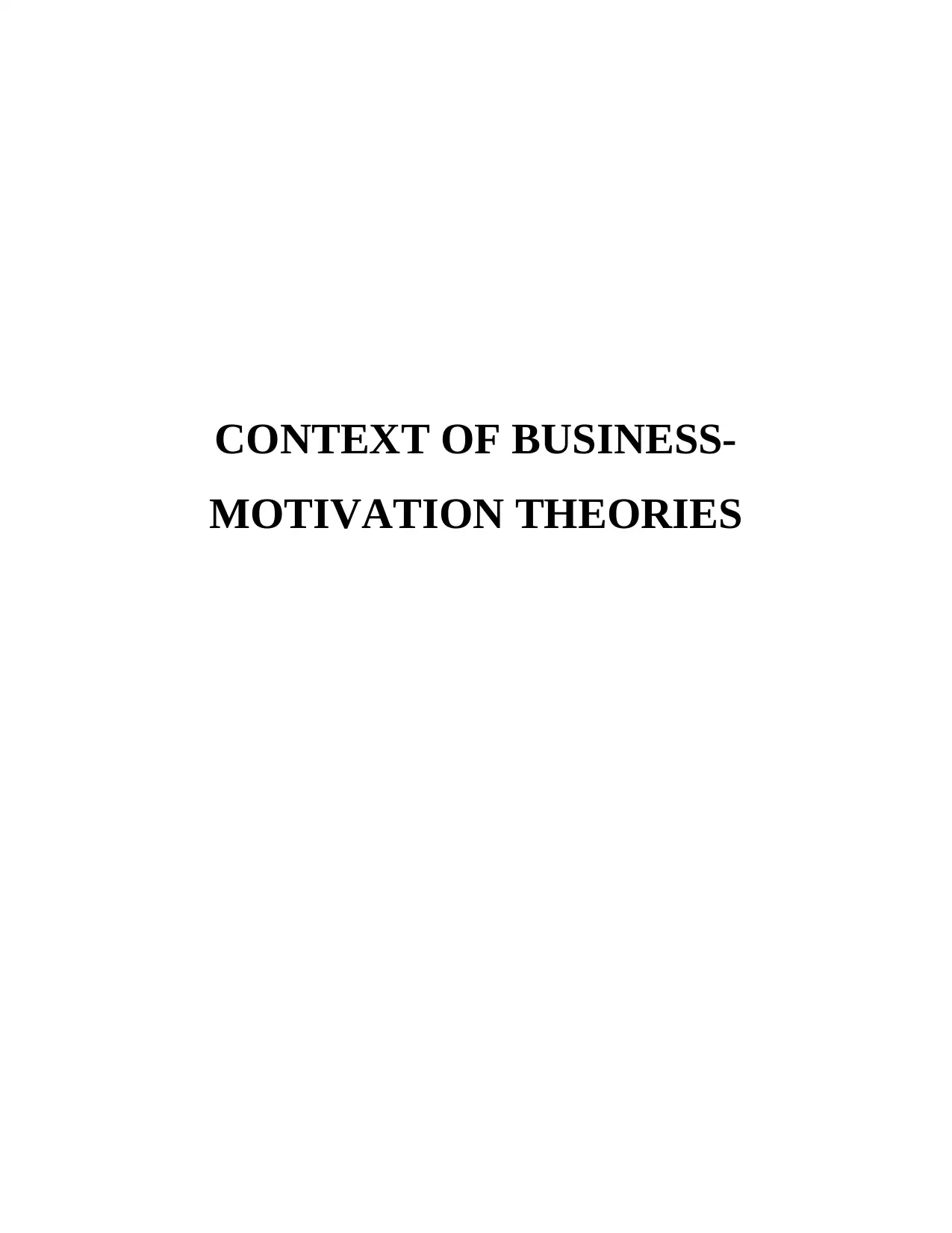
CONTEXT OF BUSINESS-
MOTIVATION THEORIES
MOTIVATION THEORIES
Paraphrase This Document
Need a fresh take? Get an instant paraphrase of this document with our AI Paraphraser
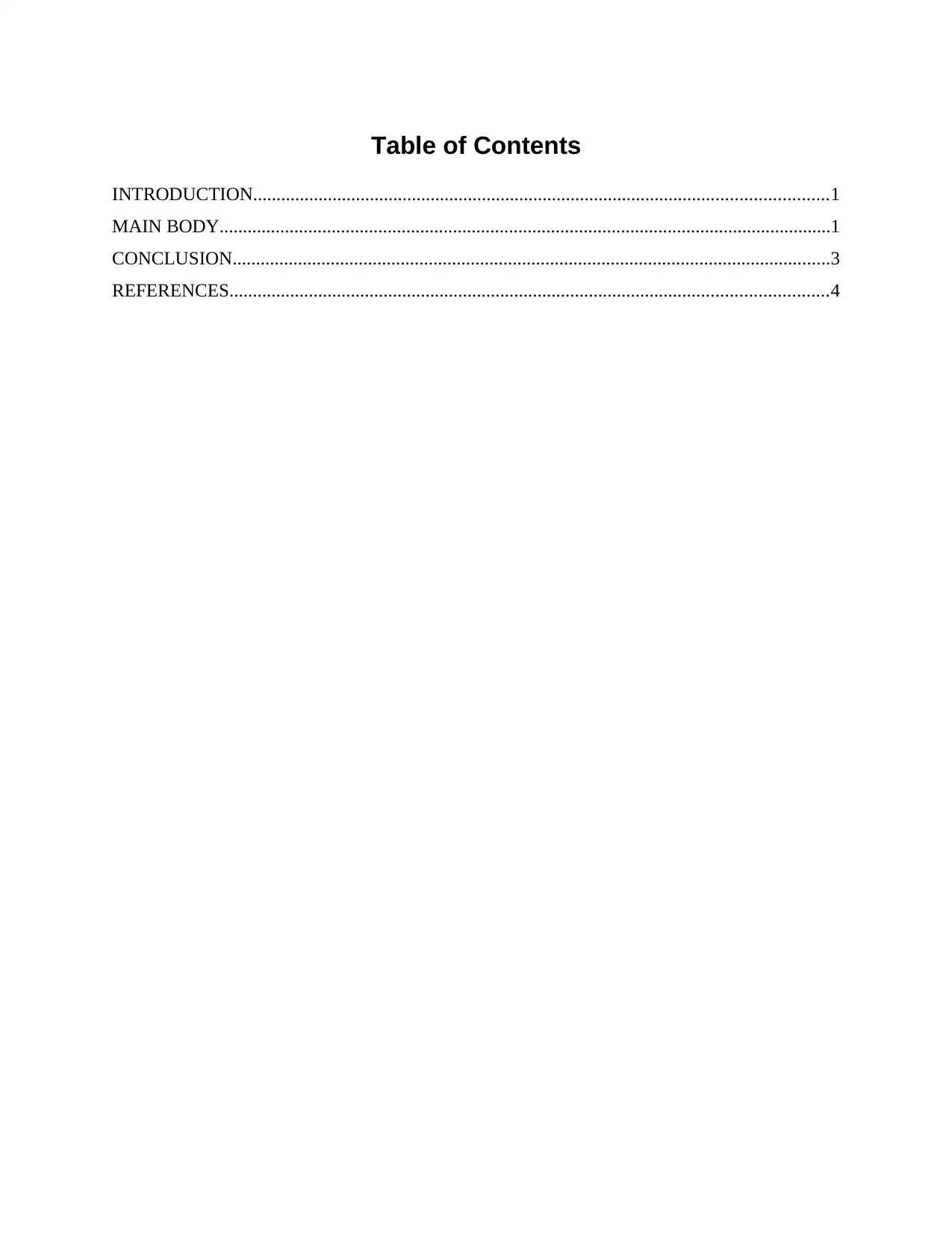
Table of Contents
INTRODUCTION...........................................................................................................................1
MAIN BODY...................................................................................................................................1
CONCLUSION................................................................................................................................3
REFERENCES................................................................................................................................4
INTRODUCTION...........................................................................................................................1
MAIN BODY...................................................................................................................................1
CONCLUSION................................................................................................................................3
REFERENCES................................................................................................................................4
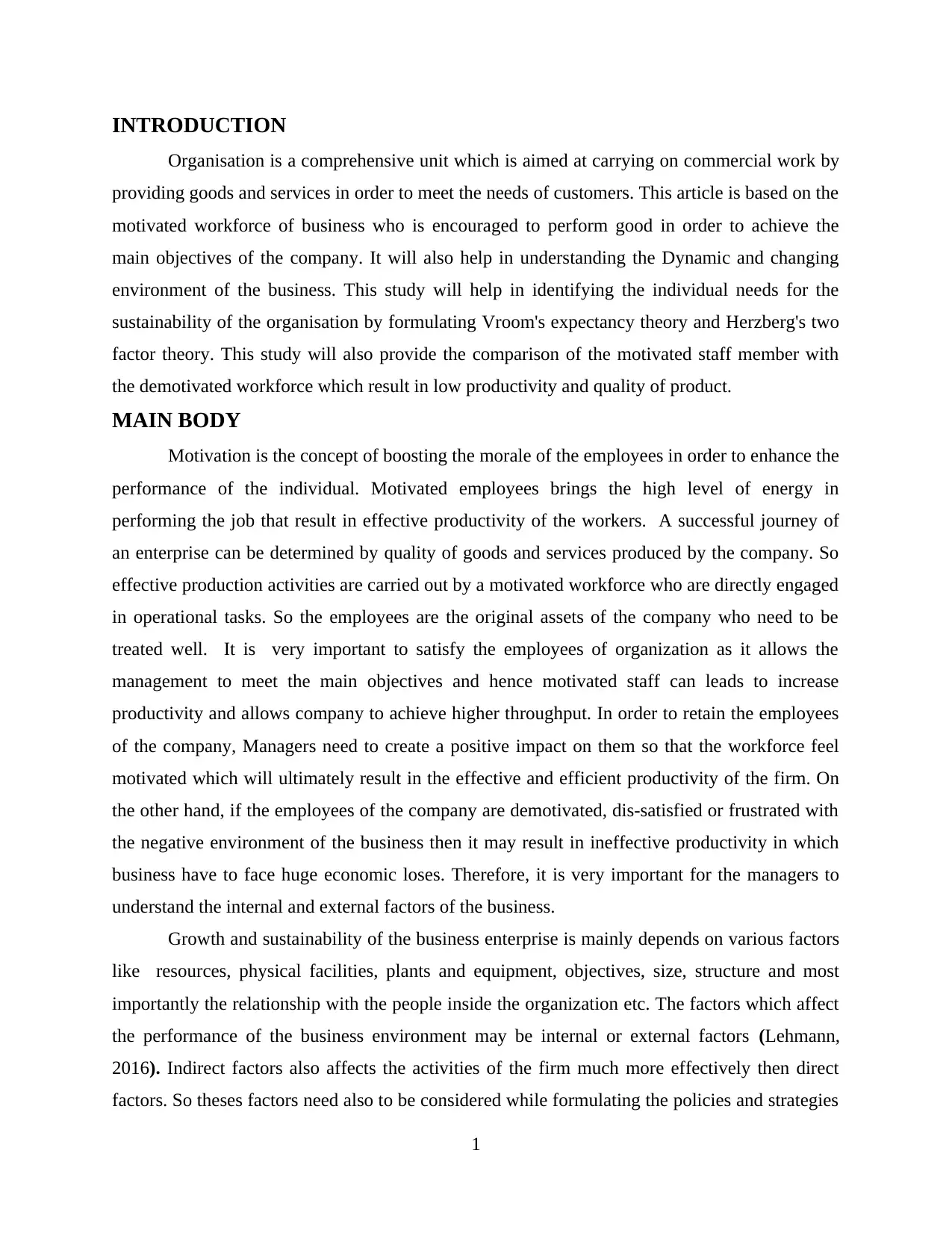
INTRODUCTION
Organisation is a comprehensive unit which is aimed at carrying on commercial work by
providing goods and services in order to meet the needs of customers. This article is based on the
motivated workforce of business who is encouraged to perform good in order to achieve the
main objectives of the company. It will also help in understanding the Dynamic and changing
environment of the business. This study will help in identifying the individual needs for the
sustainability of the organisation by formulating Vroom's expectancy theory and Herzberg's two
factor theory. This study will also provide the comparison of the motivated staff member with
the demotivated workforce which result in low productivity and quality of product.
MAIN BODY
Motivation is the concept of boosting the morale of the employees in order to enhance the
performance of the individual. Motivated employees brings the high level of energy in
performing the job that result in effective productivity of the workers. A successful journey of
an enterprise can be determined by quality of goods and services produced by the company. So
effective production activities are carried out by a motivated workforce who are directly engaged
in operational tasks. So the employees are the original assets of the company who need to be
treated well. It is very important to satisfy the employees of organization as it allows the
management to meet the main objectives and hence motivated staff can leads to increase
productivity and allows company to achieve higher throughput. In order to retain the employees
of the company, Managers need to create a positive impact on them so that the workforce feel
motivated which will ultimately result in the effective and efficient productivity of the firm. On
the other hand, if the employees of the company are demotivated, dis-satisfied or frustrated with
the negative environment of the business then it may result in ineffective productivity in which
business have to face huge economic loses. Therefore, it is very important for the managers to
understand the internal and external factors of the business.
Growth and sustainability of the business enterprise is mainly depends on various factors
like resources, physical facilities, plants and equipment, objectives, size, structure and most
importantly the relationship with the people inside the organization etc. The factors which affect
the performance of the business environment may be internal or external factors (Lehmann,
2016). Indirect factors also affects the activities of the firm much more effectively then direct
factors. So theses factors need also to be considered while formulating the policies and strategies
1
Organisation is a comprehensive unit which is aimed at carrying on commercial work by
providing goods and services in order to meet the needs of customers. This article is based on the
motivated workforce of business who is encouraged to perform good in order to achieve the
main objectives of the company. It will also help in understanding the Dynamic and changing
environment of the business. This study will help in identifying the individual needs for the
sustainability of the organisation by formulating Vroom's expectancy theory and Herzberg's two
factor theory. This study will also provide the comparison of the motivated staff member with
the demotivated workforce which result in low productivity and quality of product.
MAIN BODY
Motivation is the concept of boosting the morale of the employees in order to enhance the
performance of the individual. Motivated employees brings the high level of energy in
performing the job that result in effective productivity of the workers. A successful journey of
an enterprise can be determined by quality of goods and services produced by the company. So
effective production activities are carried out by a motivated workforce who are directly engaged
in operational tasks. So the employees are the original assets of the company who need to be
treated well. It is very important to satisfy the employees of organization as it allows the
management to meet the main objectives and hence motivated staff can leads to increase
productivity and allows company to achieve higher throughput. In order to retain the employees
of the company, Managers need to create a positive impact on them so that the workforce feel
motivated which will ultimately result in the effective and efficient productivity of the firm. On
the other hand, if the employees of the company are demotivated, dis-satisfied or frustrated with
the negative environment of the business then it may result in ineffective productivity in which
business have to face huge economic loses. Therefore, it is very important for the managers to
understand the internal and external factors of the business.
Growth and sustainability of the business enterprise is mainly depends on various factors
like resources, physical facilities, plants and equipment, objectives, size, structure and most
importantly the relationship with the people inside the organization etc. The factors which affect
the performance of the business environment may be internal or external factors (Lehmann,
2016). Indirect factors also affects the activities of the firm much more effectively then direct
factors. So theses factors need also to be considered while formulating the policies and strategies
1
⊘ This is a preview!⊘
Do you want full access?
Subscribe today to unlock all pages.

Trusted by 1+ million students worldwide
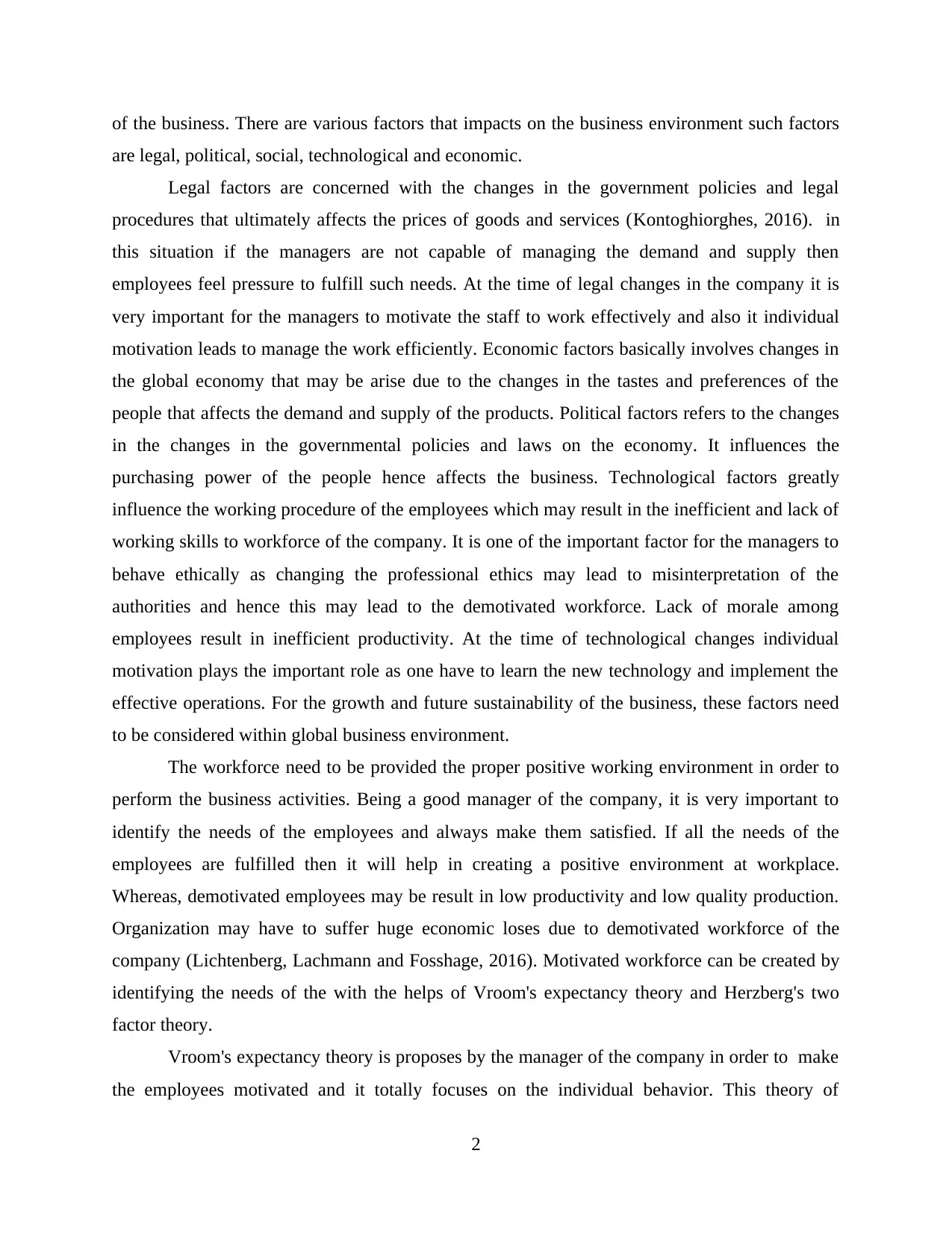
of the business. There are various factors that impacts on the business environment such factors
are legal, political, social, technological and economic.
Legal factors are concerned with the changes in the government policies and legal
procedures that ultimately affects the prices of goods and services (Kontoghiorghes, 2016). in
this situation if the managers are not capable of managing the demand and supply then
employees feel pressure to fulfill such needs. At the time of legal changes in the company it is
very important for the managers to motivate the staff to work effectively and also it individual
motivation leads to manage the work efficiently. Economic factors basically involves changes in
the global economy that may be arise due to the changes in the tastes and preferences of the
people that affects the demand and supply of the products. Political factors refers to the changes
in the changes in the governmental policies and laws on the economy. It influences the
purchasing power of the people hence affects the business. Technological factors greatly
influence the working procedure of the employees which may result in the inefficient and lack of
working skills to workforce of the company. It is one of the important factor for the managers to
behave ethically as changing the professional ethics may lead to misinterpretation of the
authorities and hence this may lead to the demotivated workforce. Lack of morale among
employees result in inefficient productivity. At the time of technological changes individual
motivation plays the important role as one have to learn the new technology and implement the
effective operations. For the growth and future sustainability of the business, these factors need
to be considered within global business environment.
The workforce need to be provided the proper positive working environment in order to
perform the business activities. Being a good manager of the company, it is very important to
identify the needs of the employees and always make them satisfied. If all the needs of the
employees are fulfilled then it will help in creating a positive environment at workplace.
Whereas, demotivated employees may be result in low productivity and low quality production.
Organization may have to suffer huge economic loses due to demotivated workforce of the
company (Lichtenberg, Lachmann and Fosshage, 2016). Motivated workforce can be created by
identifying the needs of the with the helps of Vroom's expectancy theory and Herzberg's two
factor theory.
Vroom's expectancy theory is proposes by the manager of the company in order to make
the employees motivated and it totally focuses on the individual behavior. This theory of
2
are legal, political, social, technological and economic.
Legal factors are concerned with the changes in the government policies and legal
procedures that ultimately affects the prices of goods and services (Kontoghiorghes, 2016). in
this situation if the managers are not capable of managing the demand and supply then
employees feel pressure to fulfill such needs. At the time of legal changes in the company it is
very important for the managers to motivate the staff to work effectively and also it individual
motivation leads to manage the work efficiently. Economic factors basically involves changes in
the global economy that may be arise due to the changes in the tastes and preferences of the
people that affects the demand and supply of the products. Political factors refers to the changes
in the changes in the governmental policies and laws on the economy. It influences the
purchasing power of the people hence affects the business. Technological factors greatly
influence the working procedure of the employees which may result in the inefficient and lack of
working skills to workforce of the company. It is one of the important factor for the managers to
behave ethically as changing the professional ethics may lead to misinterpretation of the
authorities and hence this may lead to the demotivated workforce. Lack of morale among
employees result in inefficient productivity. At the time of technological changes individual
motivation plays the important role as one have to learn the new technology and implement the
effective operations. For the growth and future sustainability of the business, these factors need
to be considered within global business environment.
The workforce need to be provided the proper positive working environment in order to
perform the business activities. Being a good manager of the company, it is very important to
identify the needs of the employees and always make them satisfied. If all the needs of the
employees are fulfilled then it will help in creating a positive environment at workplace.
Whereas, demotivated employees may be result in low productivity and low quality production.
Organization may have to suffer huge economic loses due to demotivated workforce of the
company (Lichtenberg, Lachmann and Fosshage, 2016). Motivated workforce can be created by
identifying the needs of the with the helps of Vroom's expectancy theory and Herzberg's two
factor theory.
Vroom's expectancy theory is proposes by the manager of the company in order to make
the employees motivated and it totally focuses on the individual behavior. This theory of
2
Paraphrase This Document
Need a fresh take? Get an instant paraphrase of this document with our AI Paraphraser
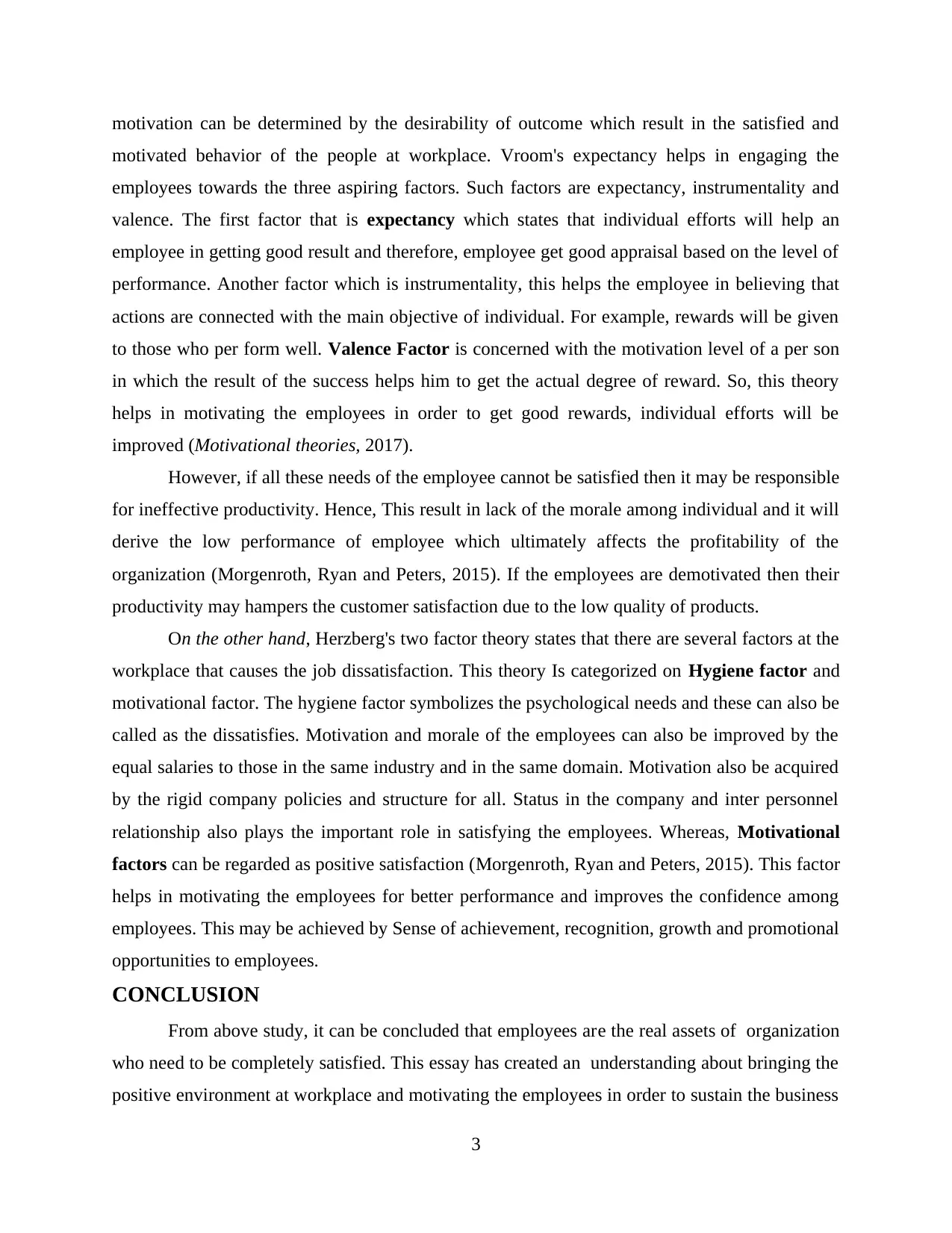
motivation can be determined by the desirability of outcome which result in the satisfied and
motivated behavior of the people at workplace. Vroom's expectancy helps in engaging the
employees towards the three aspiring factors. Such factors are expectancy, instrumentality and
valence. The first factor that is expectancy which states that individual efforts will help an
employee in getting good result and therefore, employee get good appraisal based on the level of
performance. Another factor which is instrumentality, this helps the employee in believing that
actions are connected with the main objective of individual. For example, rewards will be given
to those who per form well. Valence Factor is concerned with the motivation level of a per son
in which the result of the success helps him to get the actual degree of reward. So, this theory
helps in motivating the employees in order to get good rewards, individual efforts will be
improved (Motivational theories, 2017).
However, if all these needs of the employee cannot be satisfied then it may be responsible
for ineffective productivity. Hence, This result in lack of the morale among individual and it will
derive the low performance of employee which ultimately affects the profitability of the
organization (Morgenroth, Ryan and Peters, 2015). If the employees are demotivated then their
productivity may hampers the customer satisfaction due to the low quality of products.
On the other hand, Herzberg's two factor theory states that there are several factors at the
workplace that causes the job dissatisfaction. This theory Is categorized on Hygiene factor and
motivational factor. The hygiene factor symbolizes the psychological needs and these can also be
called as the dissatisfies. Motivation and morale of the employees can also be improved by the
equal salaries to those in the same industry and in the same domain. Motivation also be acquired
by the rigid company policies and structure for all. Status in the company and inter personnel
relationship also plays the important role in satisfying the employees. Whereas, Motivational
factors can be regarded as positive satisfaction (Morgenroth, Ryan and Peters, 2015). This factor
helps in motivating the employees for better performance and improves the confidence among
employees. This may be achieved by Sense of achievement, recognition, growth and promotional
opportunities to employees.
CONCLUSION
From above study, it can be concluded that employees are the real assets of organization
who need to be completely satisfied. This essay has created an understanding about bringing the
positive environment at workplace and motivating the employees in order to sustain the business
3
motivated behavior of the people at workplace. Vroom's expectancy helps in engaging the
employees towards the three aspiring factors. Such factors are expectancy, instrumentality and
valence. The first factor that is expectancy which states that individual efforts will help an
employee in getting good result and therefore, employee get good appraisal based on the level of
performance. Another factor which is instrumentality, this helps the employee in believing that
actions are connected with the main objective of individual. For example, rewards will be given
to those who per form well. Valence Factor is concerned with the motivation level of a per son
in which the result of the success helps him to get the actual degree of reward. So, this theory
helps in motivating the employees in order to get good rewards, individual efforts will be
improved (Motivational theories, 2017).
However, if all these needs of the employee cannot be satisfied then it may be responsible
for ineffective productivity. Hence, This result in lack of the morale among individual and it will
derive the low performance of employee which ultimately affects the profitability of the
organization (Morgenroth, Ryan and Peters, 2015). If the employees are demotivated then their
productivity may hampers the customer satisfaction due to the low quality of products.
On the other hand, Herzberg's two factor theory states that there are several factors at the
workplace that causes the job dissatisfaction. This theory Is categorized on Hygiene factor and
motivational factor. The hygiene factor symbolizes the psychological needs and these can also be
called as the dissatisfies. Motivation and morale of the employees can also be improved by the
equal salaries to those in the same industry and in the same domain. Motivation also be acquired
by the rigid company policies and structure for all. Status in the company and inter personnel
relationship also plays the important role in satisfying the employees. Whereas, Motivational
factors can be regarded as positive satisfaction (Morgenroth, Ryan and Peters, 2015). This factor
helps in motivating the employees for better performance and improves the confidence among
employees. This may be achieved by Sense of achievement, recognition, growth and promotional
opportunities to employees.
CONCLUSION
From above study, it can be concluded that employees are the real assets of organization
who need to be completely satisfied. This essay has created an understanding about bringing the
positive environment at workplace and motivating the employees in order to sustain the business
3
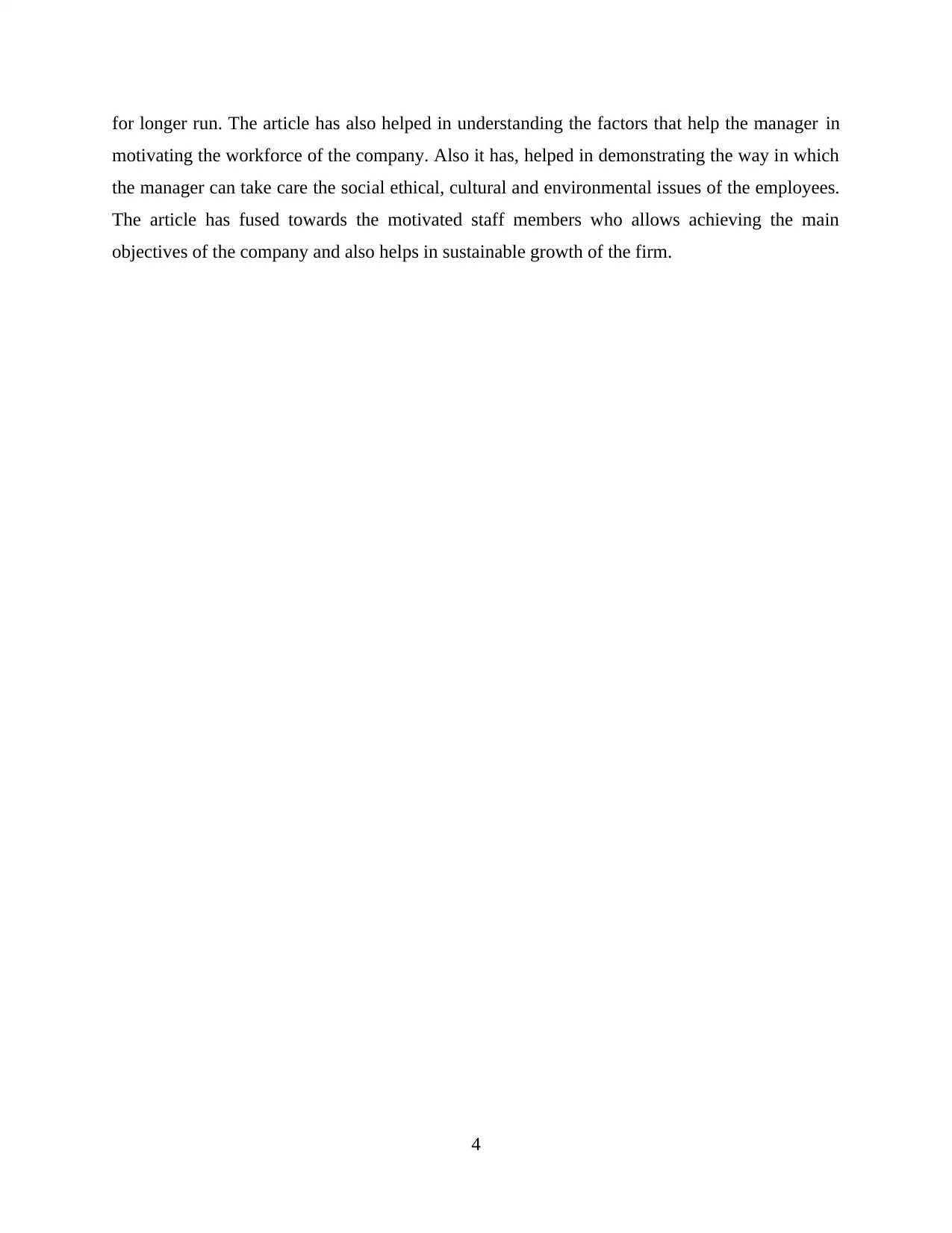
for longer run. The article has also helped in understanding the factors that help the manager in
motivating the workforce of the company. Also it has, helped in demonstrating the way in which
the manager can take care the social ethical, cultural and environmental issues of the employees.
The article has fused towards the motivated staff members who allows achieving the main
objectives of the company and also helps in sustainable growth of the firm.
4
motivating the workforce of the company. Also it has, helped in demonstrating the way in which
the manager can take care the social ethical, cultural and environmental issues of the employees.
The article has fused towards the motivated staff members who allows achieving the main
objectives of the company and also helps in sustainable growth of the firm.
4
⊘ This is a preview!⊘
Do you want full access?
Subscribe today to unlock all pages.

Trusted by 1+ million students worldwide
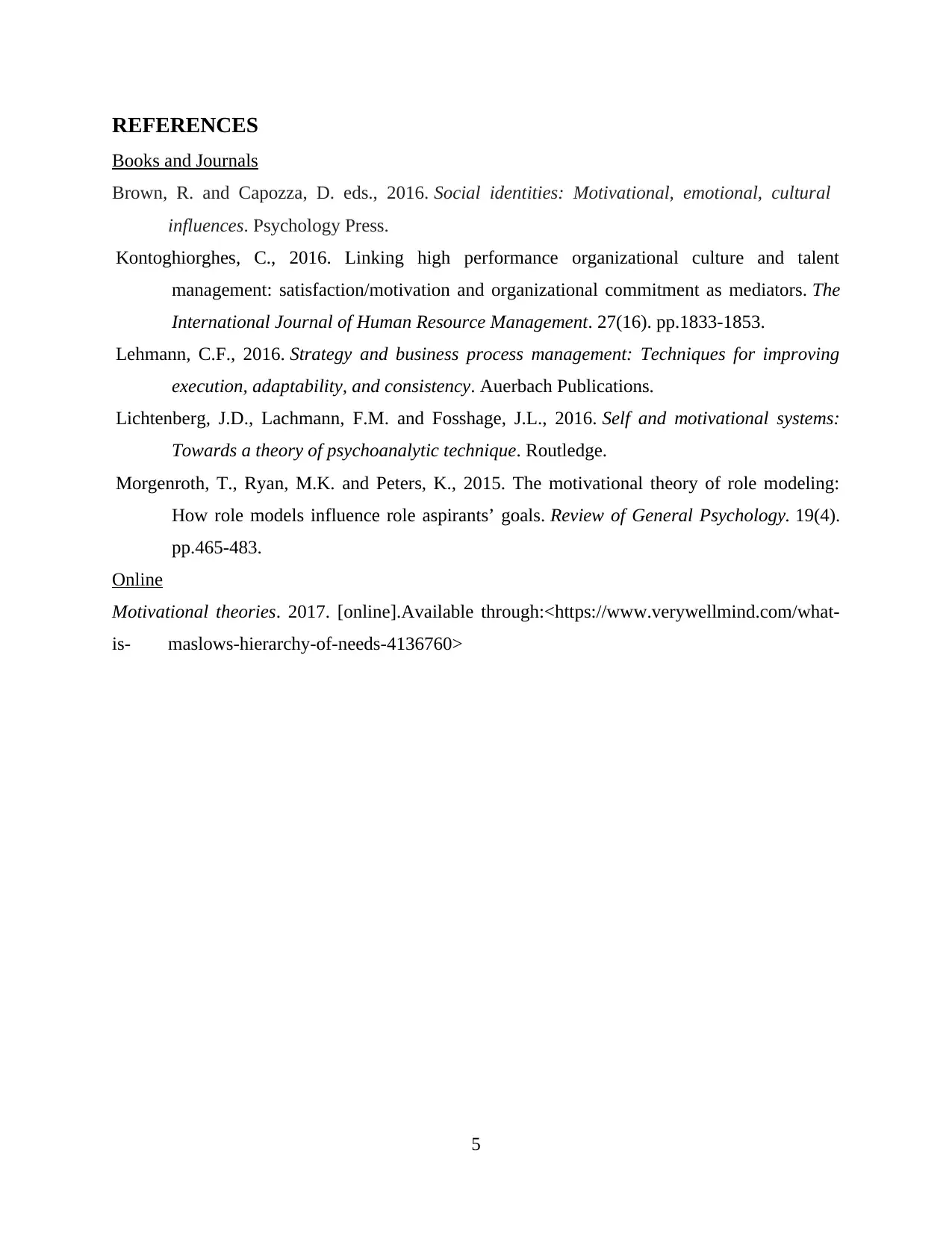
REFERENCES
Books and Journals
Brown, R. and Capozza, D. eds., 2016. Social identities: Motivational, emotional, cultural
influences. Psychology Press.
Kontoghiorghes, C., 2016. Linking high performance organizational culture and talent
management: satisfaction/motivation and organizational commitment as mediators. The
International Journal of Human Resource Management. 27(16). pp.1833-1853.
Lehmann, C.F., 2016. Strategy and business process management: Techniques for improving
execution, adaptability, and consistency. Auerbach Publications.
Lichtenberg, J.D., Lachmann, F.M. and Fosshage, J.L., 2016. Self and motivational systems:
Towards a theory of psychoanalytic technique. Routledge.
Morgenroth, T., Ryan, M.K. and Peters, K., 2015. The motivational theory of role modeling:
How role models influence role aspirants’ goals. Review of General Psychology. 19(4).
pp.465-483.
Online
Motivational theories. 2017. [online].Available through:<https://www.verywellmind.com/what-
is- maslows-hierarchy-of-needs-4136760>
5
Books and Journals
Brown, R. and Capozza, D. eds., 2016. Social identities: Motivational, emotional, cultural
influences. Psychology Press.
Kontoghiorghes, C., 2016. Linking high performance organizational culture and talent
management: satisfaction/motivation and organizational commitment as mediators. The
International Journal of Human Resource Management. 27(16). pp.1833-1853.
Lehmann, C.F., 2016. Strategy and business process management: Techniques for improving
execution, adaptability, and consistency. Auerbach Publications.
Lichtenberg, J.D., Lachmann, F.M. and Fosshage, J.L., 2016. Self and motivational systems:
Towards a theory of psychoanalytic technique. Routledge.
Morgenroth, T., Ryan, M.K. and Peters, K., 2015. The motivational theory of role modeling:
How role models influence role aspirants’ goals. Review of General Psychology. 19(4).
pp.465-483.
Online
Motivational theories. 2017. [online].Available through:<https://www.verywellmind.com/what-
is- maslows-hierarchy-of-needs-4136760>
5
1 out of 7
Related Documents
Your All-in-One AI-Powered Toolkit for Academic Success.
+13062052269
info@desklib.com
Available 24*7 on WhatsApp / Email
![[object Object]](/_next/static/media/star-bottom.7253800d.svg)
Unlock your academic potential
Copyright © 2020–2025 A2Z Services. All Rights Reserved. Developed and managed by ZUCOL.





